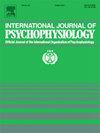Physiological arousal during encoding predicts emotional memory: An aging study of phasic and tonic skin conductance activity
IF 2.6
3区 心理学
Q3 NEUROSCIENCES
引用次数: 0
Abstract
It is widely understood that declarative memory and emotion are interconnected, although they are differentially affected by aging. However, the contributions of various aspects of physiological arousal to emotional memory, as well as the roles of valence and age in these relationships, remain unknown. This study aimed to understand the relationship between various aspects of physiological arousal and memory in younger and older adults by examining phasic and tonic skin conductance activity during an emotional verbal learning task. We recruited 26 younger adults (aged 18–35) and 24 older adults (aged 55–89), asking them to encode and recall a list of positive, negative, and neutral words across three learning trials while their skin conductance activity was measured, and to recall the words again after 10 min. We found that both groups recalled more positive and negative words than neutral words in the delayed recall trial. A positive valence effect on memory specific to the encoding phase also emerged, which aligned with a significant phasic skin conductance response (SCR) to positive words. The phasic SCR while encoding positive words predicted the subsequent recall of positive words, while tonic skin conductance level, which was lower in older adults, predicted retention of negative words after the 10-minute delay. These findings suggest that physiological arousal during encoding predicts subsequent emotional memory across different ages, with phasic and tonic arousal making the greatest contributions to positive and negative memories, respectively. Age may differentially influence tonic arousal, which affects memory, particularly for negative stimuli.
编码期间的生理唤醒预测情绪记忆:一项关于皮肤电导活动的相位和强直的衰老研究
人们普遍认为陈述性记忆和情绪是相互联系的,尽管它们受年龄的影响不同。然而,生理唤起对情绪记忆的各个方面的贡献,以及效价和年龄在这些关系中的作用,仍然未知。本研究旨在通过研究情绪性言语学习任务中皮肤电导活动的相位性和紧张性,了解年轻人和老年人生理唤醒与记忆之间的关系。我们招募了26名年轻人(18-35岁)和24名老年人(55-89岁),要求他们在三个学习试验中编码和回忆一系列积极的、消极的和中性的单词,同时测量他们的皮肤电导活动,并在10分钟后再次回忆这些单词。我们发现,在延迟回忆试验中,两组人都能回忆起更多的积极词汇和消极词汇。编码阶段对记忆的正效价效应也出现了,这与对积极词汇的显著相性皮肤电导反应(SCR)一致。编码积极词汇时的相位SCR预测了随后对积极词汇的回忆,而老年人皮肤电导水平较低,预测了10分钟后对消极词汇的记忆。这些发现表明,编码过程中的生理唤醒预测了不同年龄段的情绪记忆,其中,相位唤醒和紧张性唤醒分别对积极记忆和消极记忆贡献最大。年龄对滋补性唤醒的影响可能不同,滋补性唤醒会影响记忆,尤其是负面刺激。
本文章由计算机程序翻译,如有差异,请以英文原文为准。
求助全文
约1分钟内获得全文
求助全文
来源期刊
CiteScore
5.40
自引率
10.00%
发文量
177
审稿时长
3-8 weeks
期刊介绍:
The International Journal of Psychophysiology is the official journal of the International Organization of Psychophysiology, and provides a respected forum for the publication of high quality original contributions on all aspects of psychophysiology. The journal is interdisciplinary and aims to integrate the neurosciences and behavioral sciences. Empirical, theoretical, and review articles are encouraged in the following areas:
• Cerebral psychophysiology: including functional brain mapping and neuroimaging with Event-Related Potentials (ERPs), Positron Emission Tomography (PET), Functional Magnetic Resonance Imaging (fMRI) and Electroencephalographic studies.
• Autonomic functions: including bilateral electrodermal activity, pupillometry and blood volume changes.
• Cardiovascular Psychophysiology:including studies of blood pressure, cardiac functioning and respiration.
• Somatic psychophysiology: including muscle activity, eye movements and eye blinks.

 求助内容:
求助内容: 应助结果提醒方式:
应助结果提醒方式:


